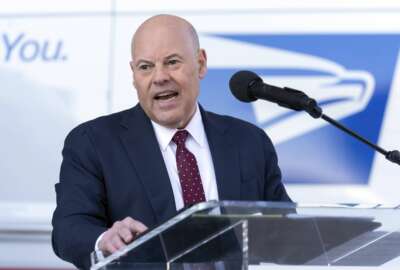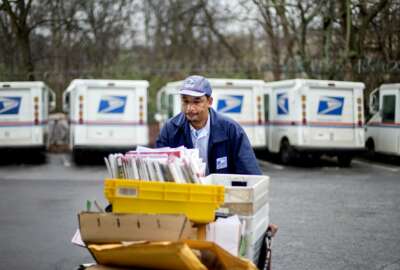
USPS commits $1.2B to lay foundation for its mostly electric next-gen fleet
The Postal Service is laying the groundwork for its plans to operate a next-generation delivery vehicle fleet that’s mostly electric.
The Postal Service is laying the groundwork for its plans to operate a next-generation delivery vehicle (NGDV) fleet that’s mostly electric.
USPS announced Tuesday it has awarded a contract to purchase 9,250 commercially available electric vehicles, as well as install 14,000 charging stations at its facilities across the country.
The agency, looking to replace its aging fleet as soon as possible, is also awarding a contract to purchase 9,250 commercially available gas-powered vehicles.
USPS is spending more than $1 billion to purchase both the commercial electric and gas-powered vehicles, as part of fixed-price contracts.
The agency estimates the total value of its charging station contracts at $260 million. USPS expects to order, at a maximum, 41,500 charging stations under its Indefinite Delivery Indefinite Quantity (IDIQ) contracts with three vendors.
USPS is using some of the $3 billion it received in the Inflation Reduction Act to purchase charging stations. USPS said it expects to purchase the commercial electric and gas-powered vehicles using its own capital funding.
In total, the Postal Service’s total investment in vehicles is expected to reach $9.6 billion, including $3 billion from the IRA funds.
The announcement Tuesday is a significant step by USPS to make its plans for a largely electric next-generation vehicle fleet a reality.
USPS last December committed that at least 75% of the custom-built next-generation delivery vehicles it’s buying from Oshkosh Defense in the next five years will be electric. The agency, at this point, expects to purchase 66,000 NGDVs from Oshkosh Defense.
USPS also committed to purchasing 100% electric NGDVs starting in 2026. In total, the agency expects to purchase 100,000 electric and gas-powered delivery vehicles through 2028.
These plans put USPS well ahead of the Biden administration’s green government goals. President Joe Biden signed an executive order in December 2021 requiring all federal agencies to purchase 100% zero-emission vehicles by 2035, and purchase only zero-emission light-duty vehicles starting in 2027.
Postmaster General Louis DeJoy said in a statement that USPS has “developed a strategy that mitigates both cost and risk of deployment — which enable execution on this initiative to begin now.”
“We are moving forward with our plans to simultaneously improve our service, reduce our cost, grow our revenue and improve the working environment for our employees,” DeJoy said. “Electrification of our vehicle fleet is now an important component of these initiatives.”
Brenda Mallory, chairwoman of the White House Council on Environmental Quality, said in a statement that “USPS’s commitment to electrification will bring cleaner air to neighborhoods and build a greener federal vehicle fleet.”
USPS has awarded a contract to Ford to provide “off-the-shelf” electric vehicles. The agency expects to start receiving those electric vehicles from Ford this December.
USPS is also awarding a contract to Fiat Chrysler Automobiles (FCA) to purchase just as many gas-powered commercial vehicles and “fill the urgent need” to replace its aging delivery fleet. The agency expects to begin receiving those gas-powered vehicles from FCA starting this November.
Both the Ford electric vehicles and the FCA gas-powered vehicles will be left-hand-drive, unlike the current USPS fleet of right-hand-drive Grumman Long Life Vehicles and the Oshkosh Defense NGDVs that will replace them.
USPS has awarded contracts to three vendors to install charging stations. The vendors are Blink Charging Company, Siemens and Rexel Energy Solutions.
USPS said in a press release it expects to install the charging stations at a minimum of 75 locations over the next 12 months.
Beyond that point, the agency said it will continue building out its electric vehicle charging infrastructure “at many additional facilities as a part of our delivery vehicle electrification strategy.”
USPS expects to install charging stations at Sorting & Delivery Centers (S&DCs), Vehicle Maintenance Facilities (VMFs), and other network facilities. It expects installations will begin in the third quarter of fiscal 2023.
USPS said it has not finalized the specific locations for the next vehicles and charging infrastructure, but said it will make that determination based on the conditions of mail delivery routes, “including whether a left-hand drive vehicle is mission-suitable, as well as other business considerations.”
Prior to its December 2022 announcement, USPS has repeatedly committed to buying more electric vehicles.
After USPS awarded its next-generation delivery vehicle contract to Oshkosh Defense in February 2022, DeJoy told Congress he expected electric vehicles would make up at least 10% of the next-generation fleet, and that the agency would buy more electric delivery vehicles if the agency could afford them.
USPS, about a month later, doubled its order for electric vehicles in the first purchase order made to Oshkosh Defense. The agency said it would purchase 10,000 electric next-generation vehicles, or 20% of its initial 50,000 NGDV order.
Last July, USPS said half its next-generation fleet order would be electric vehicles.
USPS previously got pushback from the Biden administration and environmental groups for not making a bigger investment in electric vehicles.
Several states and environmental groups filed lawsuits last April challenging an earlier plan by USPS to buy mostly gas-powered vehicles.
The lawsuits argue USPS, as part of its environmental review process, set the estimated cost for electric vehicles unrealistically high, but placed a low bar on the future price of gasoline.
Adrian Martinez, deputy managing attorney at Earthjustice, one of the lawsuit plaintiffs, said the group is “heartened” USPS is focused on purchasing EVs and charging stations.
However, Martinez said USPS should have finished its environmental review process before “sinking millions in funding the same number of combustion mail trucks that will pollute our neighborhoods for decades.”
“A thorough environmental review will show this to be a foolish waste of funds on gas-guzzling mail trucks – it’s 2023, and the United States should solely be investing in an electric future,” Martinez said.
Copyright © 2025 Federal News Network. All rights reserved. This website is not intended for users located within the European Economic Area.
Jory Heckman is a reporter at Federal News Network covering U.S. Postal Service, IRS, big data and technology issues.
Follow @jheckmanWFED
Related Stories





